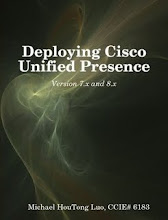CTI (Computer Telephony Interface) has been around for a while. It allows computer software control phone devices. So you can make calls, answer calls, tranfer calls, etc.
The software that controls the phone is usually referred as "CTI client". More often than not, there's a "CTI server". In Cisco products, CTI clients include Attendant Console client, Cisco Agent Desktop, etc. CTImanager on CUCM (CallManager) is the CTI server.
When a phone was controlled by CTI, the phone's staus is usually reported to CTI client. For example, when you pick up the handset on the phone, CTI client would display "off-hook" or "dial tone" on the screen. We usually refer this as "CTI status" instead of "Presence".
You can only see CTI status for the phones you controlled. You won't be able to see CTI status on other phones. CTI is more like a protocol to control the phone.
"Presence" is a rather new term comparing with CTI. "Presence" is usually referred to the SIP extension SIMPLE (Session Initiation Protocol for Instant Messaging and Presence Leveraging Extensions).
When using "Presence" with phones, we can see the status of the phone (off-hook, on-hook, do-not-disturb, etc.). You don't necessarily have control of the phone. In face, "presence" won't provide any function to control phone devices.
Keep that in mind when you troubleshoot clients (such as CUPC, MOC, etc.)
For example, when you make a call from your phone, MOC would display the phone status (CTI status). However, you might not be able to see the phone status of your contacts on MOC contact list. That part was "presence".


It was an information my best friend sildenafil gave me one year ago, and that's perfect because you right we sometimes confusing the terms.
ReplyDelete